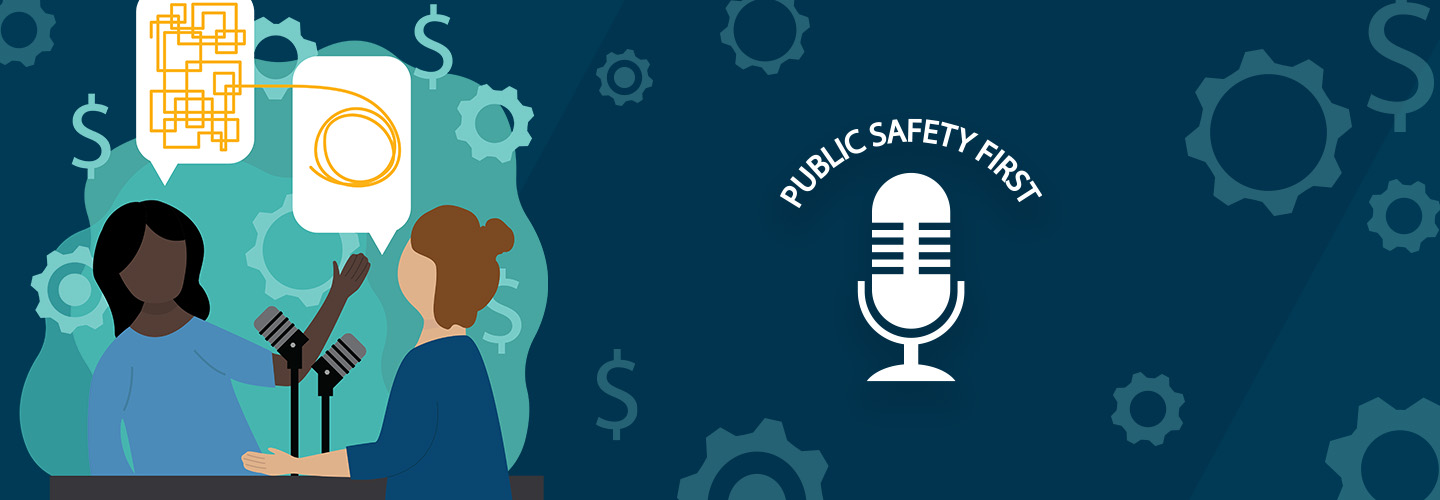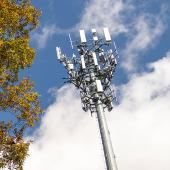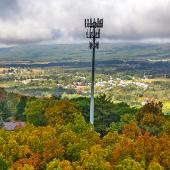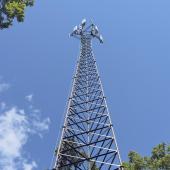Summary
Guest
Molly Hahn
Public Affairs Specialist, FirstNet Authority
Brian Hobson
Acting Assistant Executive Director for Innovation and Investment, FirstNet Authority
Transcript
Preview
Narrator: You're listening to Public Safety First, a podcast to help you learn about the First Responder Network Authority and how you can be part of the future of public safety technology.
And now, your host.
Molly Hahn: Welcome! I'm Molly Hahn, a public affairs specialist here at the FirstNet Authority, and welcome to another edition of At Its Core. Today we’re going to be talking about investments, a term here at the FirstNet Authority that is so core to our mission and allows us to continue to support public safety. I’m honored today to be joined by Brian Hobson, who’s really been at the FirstNet Authority through everything. So, Brian, welcome, and why don’t you take a minute to introduce yourself.
Narrator: You're listening to Public Safety First, a podcast to help you learn about the First Responder Network Authority and how you can be part of the future of public safety technology.
And now, your host.
Molly Hahn: Welcome! I'm Molly Hahn, a public affairs specialist here at the FirstNet Authority, and welcome to another edition of At Its Core. Today we’re going to be talking about investments, a term here at the FirstNet Authority that is so core to our mission and allows us to continue to support public safety. I’m honored today to be joined by Brian Hobson, who’s really been at the FirstNet Authority through everything. So, Brian, welcome, and why don’t you take a minute to introduce yourself.
Brian Hobson: Yeah. Thanks, Molly. My name is Brian Hobson. I've been at the FirstNet Authority for a little over ten years now. I've worked in a variety of offices, starting with the field team engaging public safety in the early days through initial consultation, data collection. From there moved into a product role as we started to form some of the initial product offerings with FirstNet Authority. Moved on to our strategy team, where I worked in a variety of fronts, including ecosystem development and ultimately the first Roadmap development from within our strategy, which has led me into my current role, which is the head of the Innovation and Investment Team, where we look at the future investments and where we want to go with the network as we go forward.
Molly Hahn: Amazing. So, you have been here through the whole experience of what is FirstNet and the FirstNet Authority so I'm sure we'll come back to you for other things in the future. But now we're kind of at this new phase of FirstNet where we're talking about these investments – what does it really mean to invest at the FirstNet Authority?
Brian Hobson: Yeah. Great question. Investment, I think, has different connotations when you talk about it. When we talk about it in terms of government, really think of investment as the funding that we get to advance our program — in this case the network— on an ongoing basis. The private sector might use terms like investment or capital, and that's a similar method in terms of the way they look to continue to advance their respective programs. So, when we talk investment, we are talking about the ongoing funding sources that we have to continue to advance the network as we move forward into the next evolution.
Molly Hahn: Why, though, is it important to keep investing in this network? What's so magical about this ongoing evolution?
Brian Hobson: Yeah. Investments are critically important. They're really key to one of the primary functions we do now in this phase of the network deployment and network oversight and where we are with the FirstNet Authority. Sometimes you'll hear us refer to that as FirstNet 3.0. And in this phase how we reinvest in the network is critically important because we want to continue to keep the network current, advance with technology. Any network like this is going to change and evolve over time. And we have, with a 25-year contract there's a lot to do to continue to evolve the network, advance the network, maintain the network, and stay very current with the technology. And that's why the investment is so important. In that we don't let the network grow stagnant we are staying responsive to needs to public safety. And we can meet not only those short-term needs but the long-term needs. And that's why we look to make these investments and plan that out over a multi-year horizon.
Molly Hahn: Yeah, that's amazing in the sense that I think about a lifespan of a career or a kid even, and that's a whole lifetime to work on. But with that said, how are we really able to do this, especially considering that it's something that's constantly evolving?
Brian Hobson: Yeah. So, when the FirstNet Authority was formed, there was a requirement for us to continue to invest in the network — to build, operate, maintain, and improve the network. Those are the specific actions that were incumbent upon us. And so, that's what we do. So, certainly the foresight of Congress when they set us up — the enabling legislation is something that mandates that we perform this, that we do it, and how we go about doing it. They've set guardrails for us to execute that. There was always a requirement from the beginning that our network be self-sustaining, that we use the initial spectrum, the initial money that we got to build this partnership to deploy a network, and importantly, to be self-sustaining, not only in our operations, the money that would be needed, the investment that would be needed to continue to advance the network. And so, that's what we've done in setting up this 25-year commitment. That was a big part of why we set up a 25-year commitment was to try to strike the right balance of having long term sustainment and dependency of having this agreement in place to maximize the value of the spectrum that we were bringing to a partnership.
So, that was the construct we put in place. We were very happy with what we realized and achieving an $18 billion in total arrangement for the 25 years. So, that commitment is laid out over the 25 years. Those annual fees that we collect are laid out as well. So, we know what amounts we're getting with a program over the next 25 years, which makes it very unique. I think not many people can say they know what their budget will look like for a 25-year foresight, and that enables us to do not only short-term planning but long-term planning, as well as have a level of certainty that we can continue to evolve and improve and advance the network over time.
Molly Hahn: That's one of those things that makes us so special that drew me to this organization. And it sounds like when you say we, Brian, you were really there from the beginning, shaping and growing this investment structure and the structure of our contract. Is that true?
Brian Hobson: Yeah, exactly. You know, so in the early days when we were doing what we call the initial consultation, it was foundational to go learn what public safety needed for that initial deployment of the network. And we often say that's kind of built into our DNA. We did that in the early days. We continue to do it today. It's really foundational to what we do. So, you know, engaging with public safety, continuing to learn from public safety, is something that not only have we done, that we continue to do, and we fully expect to do as we move forward into the future as well.
Molly Hahn: Yeah, with that feedback, who really comes up with each investment? Who gets to decide where the money goes?
Brian Hobson: Yeah. So, we have some foundational teams. And a critical function that we have within the FirstNet Authority is that ongoing engagement with public safety and engaging with them in different forms and different ways, with different users to really understand what their needs are, what's working well for them, what challenges they have, and understanding that so we can translate those operational needs into specific actions to help address or account for solving those challenges that they may have where it's relevant to a network deployment. So, that engagement is so critical. It's where it all starts.
And where it all ends, frankly, as we not only engage on the front end to learn what those needs are, but then we engage on as we deploy and post-deployment to understand how it's working, how we can continue to make improvements and enhancements as we move forward. So, it's not just in the beginning, it's in the beginning and throughout the life cycle.
And so, while public safety is critical to that, they are definitely the most important audience we engage with. It's not the only audience we engage with. We continue to engage with industry, with our partner AT&T, with other government partners that perform research, like our friends over within the Public Safety Communications Research group, PSCR. And so, working with all those different audiences, those different partners all help inform ultimately the types of things that we should be prioritizing or targeting for investment. And we use that input, that data, to really drive our investments.
Molly Hahn: I guess my next question would be, who makes the decision of when to cut the check and where the money goes?
Brian Hobson: Yeah. So, the makeup of our team really spreads across those different segments as well. So, we have folks with a background and expertise in public safety and operations from all different disciplines. We have a large amount of folks who have experience in the technology field, understand telecom, have dozens and dozens of years experience in telecom. We have those that understand government and how it works, whether it's state, local, federal. Ultimately, we are unique in that we have a board of advisors who also have that same level of experience. By mandate there is representation from public safety, there's representation from industry, there's representation from government. And that makeup of the board presents them uniquely to ultimately approve the budget that we put forward each year for reinvestment.
Molly Hahn: Excellent. I'm curious, what are some of the things we've considered for investment?
Brian Hobson: Yeah, you know, there's been a lot of work that's gone on when the reinvestment over the last few years as we've kind of built up that capability within our organization. And now, as we go forward, this is something that we've put the pieces in place that we can do this year over year. We can make these investments as money becomes available. We have a long-term plan. We have a short-term plan. We can iterate on it; be flexible in doing that. And that enables us to then be very responsive to needs as they emerge.
Up to this point, there's been investments taking those initial steps and transforming the network as we go to the next generation of technology, 5G, and everything that comes with that. As we look ahead, it's continuing to look at ways in which we can enhance or expand our 5G core, which is foundational to the network in which we deploy. We look at a lot of different ways in which we continue to deliver coverage solutions — that comes in all shapes and sizes, whether it's your traditional outdoor coverage to expand the footprint of the overall network, whether it's deployable or ad hoc coverage, and where we look at the different unique ways where we can provide on demand, on the spot coverage, whether that's what we deploy or we enable for agencies to deploy that themselves. And we're really looking at how we continue to evolve our mission critical services portfolio. Foundational to communications are push-to-talk voice, video, data, and embed it into our network. We're looking at how we advance that overall offering as we go forward.
And those are just some examples of evolving the core, the underlying network, advancing the underlying technology, looking at different ways we continue to deliver coverage, and looking at mission critical services and advancing those overall capabilities.
Molly Hahn: How is public safety directly benefiting from this kind of stuff?
Brian Hobson: Yeah, this is an area where, you know, we often talk about what makes us different and unique in the FirstNet network. We know we're not the only telecom network. We're not the only ones deploying 5G. We're not the only ones deploying more spectrum to deliver capabilities. We are the only ones, however, that are focusing the entirety of our network on public safety needs. And so, that's really what these investments yield, I think, a lot of benefit is that we look at the unique needs of public safety, and we're deploying services in some capabilities that you won't see on other networks that are very unique to what we're trying to do. We can build upon where the industry goes; we know there are commonalities, of course, and what we may use as consumers and our day-to-day lives. That's no different in some cases for public safety. And so, we can build upon some of those capabilities, but we can then really deploy and focus our attention on those unique services, capabilities that public safety needs. And that's where we think our investment brings tremendous benefit.
Molly Hahn: Yeah. And this gets me excited. You know, I've been here since 2021. And to keep going and to see that we're finally kind of getting this rhythm of investment.
If I was somebody who was just now finding out about FirstNet or FirstNet Authority, or I've heard about it for a long time, but now I'm inspired, how would I get involved? How would I learn more about investments, or learn more about how to give my feedback as a public safety stakeholder?
Brian Hobson: Yeah. Great question, Molly. So, we are constantly engaging with public safety, trying to learn what's needed. There's a variety of different forms you can engage. Certainly, you know, major conferences, different engagements. We're always coming into your own backyard to learn from you. Those are different ways to learn, engage. Our website has great information on our points of contacts within your local geographic region or your discipline. That's a great way to learn and see what's going on in your area. I know we've got a great presence, credit to you and the team on our social media. So, following us, whether it's Instagram or Facebook or LinkedIn. Lots of great information there. There's many different ways in which you can learn about what's going on and find ways to engage and make sure that your voice is heard in the work we do.
Molly Hahn: Well, thank you. It's good to know that that kind of resource is really valued.
I can't thank you enough for your time today. I feel like I'm more knowledgeable on investments. It's great to have you here. I hope this detangled things a little bit, and I look forward to what's to come. Thanks again, Brian.
Brian Hobson: Absolutely. Thanks, Molly. It’s a team of a lot of dedicated individuals that make this happen and make it a reality. It’s really exciting now to see us looking into the future and taking this program into that next phase, the FirstNet 3.0 phase, where we're building on and evolving and continuing to meet the ongoing needs of public safety.
Narrator: Thanks for listening today. We're excited to have you join our podcast community. Make sure to subscribe on iTunes, SoundCloud, and YouTube. You can learn more about the First Responder Network Authority at FirstNet.gov and learn about FirstNet products and services at FirstNet.com.
















